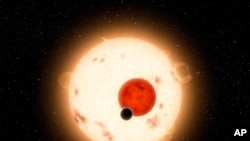Astronomers say they have discovered a planet that orbits around a pair of stars. It is the first time a so-called circumbinary system has been detected.
Movie fans might be familiar with the score of "Star Wars, Episode IV, A New Hope," the blockbuster movie from 1977. Luke Skywalker stands on his stark home planet Tatooine. As he gazes pensively into the distance toward a pinkish sky, an orange sun descends toward the horizon, with a smaller white sun following close behind.
Well, move over, Tatooine, says John Knoll of Industrial Light and Magic, which created the special effects for the "Star Wars" films.
"Again and again we see that the science is stranger and cooler than the fiction," Knoll said.
Make way for reality -- Kepler-16b, the first planet known to definitively orbit two stars. That makes it a circumbinary planet.
A research team, led by scientist Laurance Doyle, used data from the Kepler space telescope to make the discovery.
Kepler-16b is 200 light years from Earth. It is about the mass of Saturn, and it is half-rock and half-gas. It is in orbit around two stars that are smaller than our Sun, and those two stars are in what Doyle calls "an eccentric orbit" around each other.
"Well, this is an example of another planetary system. A completely different type that we've never seen before. And so that's why everybody is making a big deal of it. Nobody's ever seen a place like this before. . . with one exception. I seem to remember seeing a place like this about 30 years ago in a galaxy far, far away...," Doyle said.
And that would, of course, be the "Star Wars" fictional planet Tatooine.
Researchers describe this newly discovered Kepler system as a rather graceful one. The two stars twirl around each other every 41 days. The planet orbits in a circle around both of the stars every 229 days.
But how did researchers find it?
The Kepler space telescope measures changes in the brightness of more than 150,000 stars as it searches for transiting planets.
All three bodies in this system orbit in the same plane, and that is why the telescope observed the various planetary and stellar eclipses. The dimming in brightness at irregular intervals indicated the stars were in different positions in their orbit each time they were passed by the third body, planet Kepler-16b.
"We have two stars dancing around each other, and in our line of sight, they eclipse each other, and then we have this exquisite little pirouette of the planet going around both of them, and we get to see how big the planet is as well," Doyle said.
Scientists were able to deduce the planet's mass by the gravitational tug on the stars, as measured by changes in their eclipse times.
The goal of the Kepler mission is to find other Earth-like planets that could support life. Doyle says this planet is not habitable.
"The bright star is kind of orange. It's more orange than the sun. And the little star is red. It's very red. So that's an example of another thing to be considered when you talk about habitable planets is, 'what is the color of the light?' Is it color that plants can use to photosynthesize, and so on?," Doyle said.
Doyle says researchers do not yet know the rotation period, so they do not yet know the planet's sunrises and sunsets. But, he said, they would be dynamic because of the stars' eccentric orbits. Sometimes the red star would set first, sometimes the orange one. Sometimes they would set together.
"You'd have, of course, two shadows, because the orange star would cast a shadow, but the red star would fill it in because it's at a different angular point in the sky, and vice versa. So, if you want to tell the time by sundial, you'd need calculus, you know," Doyle said.
The findings are described in a study published in the September 16th issue of the journal Science.
Scientists Discover 1 Planet Orbiting 2 Stars






